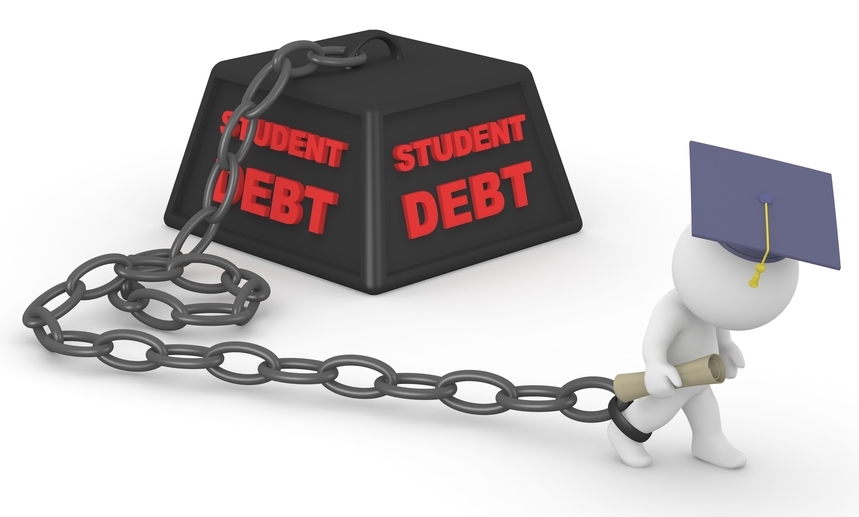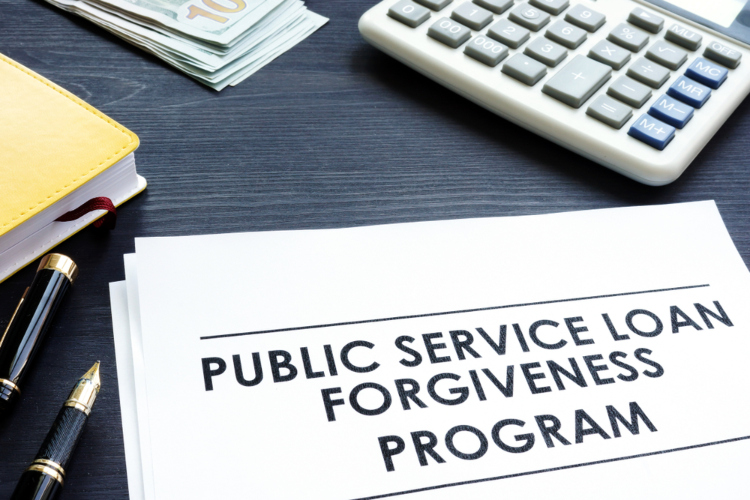Student loan forgiveness: Great in theory, murky in practice

Image from Shutterstock.com.
To afford law school, Kyle Ingram borrowed $120,000. Saddled with this significant loan balance at age 27, he sought debt forgiveness through the Public Service Loan Forgiveness program.
Established in 2007, the PSLF program allows people with federally backed loans to work for a qualifying government or nonprofit public service organization while making payments under one of four federal qualified repayment programs for 120 months.
As such, Ingram says he passed up more lucrative opportunities to qualify for the program. Since graduating from the University of Oregon in 2012, Ingram, who’s based in Washington, D.C., has worked as an attorney for various federal agencies and currently makes an annual salary of $84,000.
Last year, Ingram watched the first cohorts of PSLF applicants file for debt forgiveness. The results were unsettling. In September, the U.S. Department of Education, which administers the program, approved less than 1 percent of applicants. Ninety-nine percent, the department reported, either did not meet the program’s requirements or had incomplete applications.
While some say this is just the struggle of a new program, others, such as student loan expert Heather Jarvis, say the denial rate illustrates that loan repayment and forgiveness is excessively convoluted. Acknowledging there is confusion over the program, in December, the DOE launched an online tool to help borrowers understand and participate in loan forgiveness.
For Ingram, a veteran, he says he’s “nervous” about the choice he’s made.
Since graduating in 2012, he has repaid $39,000 while his student debt has ballooned to $166,000 because of interest. (Editor’s note: The author of this story attended law school with Ingram.)
“I stayed with the federal government, in part, for the student loan forgiveness,” he says. Even with the uncertainty, five and a half years in, he’s determined to get through the 10 years of repayment and have his debt forgiven. “I’m all in on this public service loan forgiveness,” he says.
With the high price of law school, PSLF and income-based repayment have become popular repayment options over the past decade. Now, with law school matriculation on the uptick, access to these repayment programs may be curtailed, which could hurt law schools and leave borrowers aggrieved.
Since the ABA started collecting law school tuition data in the 1980s, tuition at a public institution for nonresidents has nearly quadrupled when adjusted for inflation. Private institutions saw tuition increased almost threefold.
To help students, law schools increased scholarships and grants. However, when applications slowed at the decade’s beginning, schools shifted money from need-based grants to merit-based scholarships to attract top students.
“Currently, the bulk of law school scholarships are awarded based on factors, like LSAT scores, that tend to favor students with less financial need, leaving students with the most need having to rely more heavily on student loans,” says Aaron Taylor, executive director of the AccessLex Center for Legal Education Excellence.
To cover the immense costs, students are borrowing a lot of money. Christopher Chapman, president and CEO at AccessLex, estimates that $3.3 billion is borrowed each year by about 120,000 students to cover legal education costs. In 2017, the average law school graduate borrowed $108,000 while making a starting median salary of $70,000, according to the group.
Today, student debt tops $1.5 trillion, five times what it was in 2001. Some worry that this debt “bubble” could lead to financial collapse if defaults increased. However, according to Chapman, this is unlikely, in part because of more forgiving and flexible repayment plans enacted in 2007.
 Image from Shutterstock.com.
Image from Shutterstock.com.
TERMS MAY VARY
While the terms of PSLF sound straightforward, the 99 percent denial rate indicates otherwise.
“The department expects few people to be immediately eligible for a loan discharge under the Public Service Loan Forgiveness program due, in large part, to complexities of the program Congress created more than a decade ago,” said DOE press secretary Liz Hill in an emailed statement. “Such complexities include restrictions on the types of eligible loans, the limited availability of income-based repayment plans in the early years of the program, and no authority to require borrowers to annually report their participation in the program.”
Further, what qualifies as a “public service” organization is at issue in litigation.
The ABA sued the Department of Education in 2016 on behalf of four lawyers for revoking eligibility to the program. The DOE responded that it never issued an approval to participate in PSLF, and the approvals from its servicer were tentative.
“Ten years ago, the federal government made a promise to forgive some student loan debt to encourage young people to take on lower-paid jobs that serve the public,” said ABA President Bob Carlson in a statement to the ABA Journal. “Thousands of graduates made major life decisions based on that promise. They took on debts, moved to new cities and accepted new jobs, often for many years. The ABA plans to vigorously continue its lawsuit to force the Education Department to keep its promise.”
In late February, the U.S. District Court for the District of Columbia ruled that the DOE acted arbitrarily and capriciously when it changed its interpretation of the PSLF regulation. Also, the Feb. 22 finding granted the DOE’s summary judgment motion against the ABA, finding that the department’s determination that the ABA did not qualify as a public service organization in regards to the PSLF program was not a final agency action, so Administrative Procedure Act requirements did not apply.
“We are carefully considering all our options going forward and it is our hope that the department will take seriously its responsibility to comply with the law when re-considering the claims of eligibility, for these borrowers and others,” said Chong S. Park, a partner at Ropes & Gray who represents the plaintiffs pro bono, in a statement.
Those not working for a qualifying public service organization can utilize income-based repayment. As of July 2014, new borrowers pay 10 percent of their income for 20 years. After the repayment period, the principle and interest are discharged and taxed as income.
Both IBR and PSLF currently do not have caps on how much can be borrowed, forgiven or discharged. Some worry this has given law schools carte blanche to raise tuition rates.
“The students can borrow as much money through those programs as they want,” said Barry Currier, the ABA’s managing director of accreditation and legal education, speaking on his own behalf at the 2018 ABA Midyear Meeting in Vancouver, British Columbia. “So if Harvard Law School or New England Law School said, ‘Tuition at our school next year is $200,000, and living expenses are $50,000,’ the federal government wouldn’t say, ‘You’ve got to be kidding me!’ They would say, ‘Where can we send that check for $250,000?’ ”
A few years ago, the Obama administration recommended capping the amount of money that could be forgiven under PSLF at $57,000. The proposal never became a reality, but the Congressional Budget Office released projections in December 2018 showing that if PSLF forgiveness was capped at $57,500, then $9.3 billion in debt would shift back onto borrowers over 10 years.
In 2017, President Donald Trump proposed a budget that eliminated the program entirely. About a year later, a bill proposed in Congress would have put an annual cap of $28,500 on borrowing for graduate and professional education and ended loan forgiveness programs. According to Currier, a bill such as this is a very serious issue for law schools because it likely would depress the number of new students.
Gregory Crespi, a professor at Southern Methodist University’s Dedman School of Law, thinks these potential changes open up serious questions for those already in repayment and for future borrowers.
Crespi says if someone started school under the current income-based repayments rules but those were changed before they signed up for the repayment program, then they would be subject to the new rules and not have recourse through the courts—even if they relied on the earlier terms. However, those who signed up for IBR before a statutory change likely are safe because they have legal protections against revocation.
Not so lucky are those already repaying or expecting to repay through PSLF. Crespi says there isn’t a contract between the borrower and the government like with IBR, meaning that if the program ended, borrowers might not have legal recourse. “You can tell a pretty good sob story,” he says, but “I’m not sure how a constitutional challenge would work.”
While he doesn’t think PSLF will be revoked anytime soon, he says those starting law school in the fall have at least 13 years between their first loan and making the final PSLF payment, which creates risk for the borrower.
“It’s a nice deal,” Crespi says about PSLF. “But, gosh, I hope it sticks around.”
Write a letter to the editor, share a story tip or update, or report an error.


